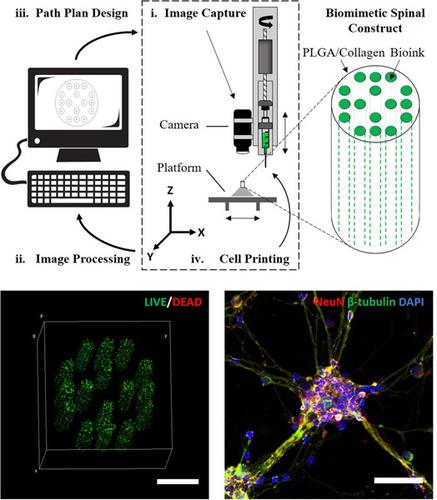当前位置:
X-MOL 学术
›
Biotechnol. Bioeng.
›
论文详情
Our official English website, www.x-mol.net, welcomes your
feedback! (Note: you will need to create a separate account there.)
Fabrication of a biomimetic spinal cord tissue construct with heterogenous mechanical properties using intrascaffold cell assembly.
Biotechnology and Bioengineering ( IF 3.5 ) Pub Date : 2020-06-15 , DOI: 10.1002/bit.27459 Kevin F Firouzian 1, 2, 3 , Yu Song 1, 2, 3 , Feng Lin 1, 2, 3 , Ting Zhang 1, 2, 3
Biotechnology and Bioengineering ( IF 3.5 ) Pub Date : 2020-06-15 , DOI: 10.1002/bit.27459 Kevin F Firouzian 1, 2, 3 , Yu Song 1, 2, 3 , Feng Lin 1, 2, 3 , Ting Zhang 1, 2, 3
Affiliation

|
In tissue engineering studies, scaffolds play a very important role in offering both physical and chemical cues for cell growth and tissue regeneration. However, in some cases, tissue regeneration requires scaffolds with high mechanical properties (e.g., bone and cartilage), while cells need a soft mechanical microenvironment. In this study, to mimic the heterogenous mechanical properties of a spinal cord tissue, a biomimetic rat tissue construct is fabricated. A collagen‐coated poly(lactic‐co‐glycolic acid) scaffold is manufactured using thermally induced phase separation casting. Primary rat neural cells (P01 Wistar rat cortex) with soft hydrogels are later printed within the scaffold using an image‐guided intrascaffold cell assembly technique. The scaffolds have unidirectional microporous structure with parallel axial macrochannels (260 ± 4 µm in diameter). Scaffolds showed mechanical properties similar to rat spine (ultimate tensile strength: 0.085 MPa, Young's modulus [stretch]: 0.31 MPa). The bioink composed of gelatin/alginate/fibrinogen is precisely printed into the macrochannels and showed mechanical properties suitable for neural cells (Young's modulus [compressive]: 3.814 kPa). Scaffold interface, cell viability, and immunostaining analyses show uniform distribution of stable, healthy, and elongated neural cells and neurites over 14 culture days in vitro. The results demonstrated that this method can serve as a valuable tool to aid manufacturing of tissue constructs requiring heterogenous mechanical properties for complex cell and/or biomolecule assembly.
中文翻译:

使用支架内细胞组装制造具有异质机械特性的仿生脊髓组织结构。
在组织工程研究中,支架在为细胞生长和组织再生提供物理和化学线索方面发挥着非常重要的作用。然而,在某些情况下,组织再生需要具有高机械性能的支架(例如骨骼和软骨),而细胞需要柔软的机械微环境。在这项研究中,为了模拟脊髓组织的异质机械特性,制造了仿生大鼠组织结构。使用热诱导相分离浇铸制造了胶原涂层的聚(乳酸-共-乙醇酸)支架。随后使用图像引导的支架内细胞组装技术将带有软水凝胶的原代大鼠神经细胞(P01 Wistar 大鼠皮层)打印在支架内。支架具有单向微孔结构,具有平行的轴向大通道(直径为 260 ± 4 µm)。支架显示出类似于大鼠脊柱的机械性能(最终拉伸强度:0.085 MPa,杨氏模量 [拉伸]:0.31 MPa)。由明胶/藻酸盐/纤维蛋白原组成的生物墨水被精确地打印到大通道中,并显示出适合神经细胞的机械性能(杨氏模量 [压缩]:3.814 kPa)。支架界面、细胞活力和免疫染色分析显示,在 14 天的体外培养中,稳定、健康和细长的神经细胞和神经突均匀分布。结果表明,这种方法可以作为一种有价值的工具来帮助制造需要异质机械性能的复杂细胞和/或生物分子组装的组织结构。支架显示出类似于大鼠脊柱的机械性能(最终拉伸强度:0.085 MPa,杨氏模量 [拉伸]:0.31 MPa)。由明胶/藻酸盐/纤维蛋白原组成的生物墨水被精确地打印到大通道中,并显示出适合神经细胞的机械性能(杨氏模量 [压缩]:3.814 kPa)。支架界面、细胞活力和免疫染色分析显示,在 14 天的体外培养中,稳定、健康和细长的神经细胞和神经突均匀分布。结果表明,这种方法可以作为一种有价值的工具来帮助制造需要异质机械性能的复杂细胞和/或生物分子组装的组织结构。支架显示出类似于大鼠脊柱的机械性能(最终拉伸强度:0.085 MPa,杨氏模量 [拉伸]:0.31 MPa)。由明胶/藻酸盐/纤维蛋白原组成的生物墨水被精确地打印到大通道中,并显示出适合神经细胞的机械性能(杨氏模量 [压缩]:3.814 kPa)。支架界面、细胞活力和免疫染色分析显示,在 14 天的体外培养中,稳定、健康和细长的神经细胞和神经突均匀分布。结果表明,这种方法可以作为一种有价值的工具来帮助制造需要异质机械性能的复杂细胞和/或生物分子组装的组织结构。31 兆帕)。由明胶/藻酸盐/纤维蛋白原组成的生物墨水被精确地打印到大通道中,并显示出适合神经细胞的机械性能(杨氏模量 [压缩]:3.814 kPa)。支架界面、细胞活力和免疫染色分析显示,在 14 天的体外培养中,稳定、健康和细长的神经细胞和神经突均匀分布。结果表明,这种方法可以作为一种有价值的工具来帮助制造需要异质机械性能的复杂细胞和/或生物分子组装的组织结构。31 兆帕)。由明胶/藻酸盐/纤维蛋白原组成的生物墨水被精确地打印到大通道中,并显示出适合神经细胞的机械性能(杨氏模量 [压缩]:3.814 kPa)。支架界面、细胞活力和免疫染色分析显示,在 14 天的体外培养中,稳定、健康和细长的神经细胞和神经突均匀分布。结果表明,这种方法可以作为一种有价值的工具来帮助制造需要异质机械性能的复杂细胞和/或生物分子组装的组织结构。和免疫染色分析显示,在体外培养 14 天后,稳定、健康和细长的神经细胞和神经突的均匀分布。结果表明,这种方法可以作为一种有价值的工具来帮助制造需要异质机械性能的复杂细胞和/或生物分子组装的组织结构。和免疫染色分析显示,在体外培养 14 天后,稳定、健康和细长的神经细胞和神经突的均匀分布。结果表明,这种方法可以作为一种有价值的工具来帮助制造需要异质机械性能的复杂细胞和/或生物分子组装的组织结构。
更新日期:2020-06-15
中文翻译:

使用支架内细胞组装制造具有异质机械特性的仿生脊髓组织结构。
在组织工程研究中,支架在为细胞生长和组织再生提供物理和化学线索方面发挥着非常重要的作用。然而,在某些情况下,组织再生需要具有高机械性能的支架(例如骨骼和软骨),而细胞需要柔软的机械微环境。在这项研究中,为了模拟脊髓组织的异质机械特性,制造了仿生大鼠组织结构。使用热诱导相分离浇铸制造了胶原涂层的聚(乳酸-共-乙醇酸)支架。随后使用图像引导的支架内细胞组装技术将带有软水凝胶的原代大鼠神经细胞(P01 Wistar 大鼠皮层)打印在支架内。支架具有单向微孔结构,具有平行的轴向大通道(直径为 260 ± 4 µm)。支架显示出类似于大鼠脊柱的机械性能(最终拉伸强度:0.085 MPa,杨氏模量 [拉伸]:0.31 MPa)。由明胶/藻酸盐/纤维蛋白原组成的生物墨水被精确地打印到大通道中,并显示出适合神经细胞的机械性能(杨氏模量 [压缩]:3.814 kPa)。支架界面、细胞活力和免疫染色分析显示,在 14 天的体外培养中,稳定、健康和细长的神经细胞和神经突均匀分布。结果表明,这种方法可以作为一种有价值的工具来帮助制造需要异质机械性能的复杂细胞和/或生物分子组装的组织结构。支架显示出类似于大鼠脊柱的机械性能(最终拉伸强度:0.085 MPa,杨氏模量 [拉伸]:0.31 MPa)。由明胶/藻酸盐/纤维蛋白原组成的生物墨水被精确地打印到大通道中,并显示出适合神经细胞的机械性能(杨氏模量 [压缩]:3.814 kPa)。支架界面、细胞活力和免疫染色分析显示,在 14 天的体外培养中,稳定、健康和细长的神经细胞和神经突均匀分布。结果表明,这种方法可以作为一种有价值的工具来帮助制造需要异质机械性能的复杂细胞和/或生物分子组装的组织结构。支架显示出类似于大鼠脊柱的机械性能(最终拉伸强度:0.085 MPa,杨氏模量 [拉伸]:0.31 MPa)。由明胶/藻酸盐/纤维蛋白原组成的生物墨水被精确地打印到大通道中,并显示出适合神经细胞的机械性能(杨氏模量 [压缩]:3.814 kPa)。支架界面、细胞活力和免疫染色分析显示,在 14 天的体外培养中,稳定、健康和细长的神经细胞和神经突均匀分布。结果表明,这种方法可以作为一种有价值的工具来帮助制造需要异质机械性能的复杂细胞和/或生物分子组装的组织结构。31 兆帕)。由明胶/藻酸盐/纤维蛋白原组成的生物墨水被精确地打印到大通道中,并显示出适合神经细胞的机械性能(杨氏模量 [压缩]:3.814 kPa)。支架界面、细胞活力和免疫染色分析显示,在 14 天的体外培养中,稳定、健康和细长的神经细胞和神经突均匀分布。结果表明,这种方法可以作为一种有价值的工具来帮助制造需要异质机械性能的复杂细胞和/或生物分子组装的组织结构。31 兆帕)。由明胶/藻酸盐/纤维蛋白原组成的生物墨水被精确地打印到大通道中,并显示出适合神经细胞的机械性能(杨氏模量 [压缩]:3.814 kPa)。支架界面、细胞活力和免疫染色分析显示,在 14 天的体外培养中,稳定、健康和细长的神经细胞和神经突均匀分布。结果表明,这种方法可以作为一种有价值的工具来帮助制造需要异质机械性能的复杂细胞和/或生物分子组装的组织结构。和免疫染色分析显示,在体外培养 14 天后,稳定、健康和细长的神经细胞和神经突的均匀分布。结果表明,这种方法可以作为一种有价值的工具来帮助制造需要异质机械性能的复杂细胞和/或生物分子组装的组织结构。和免疫染色分析显示,在体外培养 14 天后,稳定、健康和细长的神经细胞和神经突的均匀分布。结果表明,这种方法可以作为一种有价值的工具来帮助制造需要异质机械性能的复杂细胞和/或生物分子组装的组织结构。











































 京公网安备 11010802027423号
京公网安备 11010802027423号